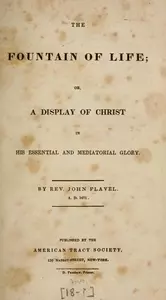A fragrant Christian life: Margaret Stewart Sandeman
At the age of fifteen, Margaret Stewart, a native of Perth, Scotland, was sent to a Christian residential school in the English city of Newcastle. She had not been there long when one of the teachers, a Miss Smith, put a startling question to her: “Miss Stewart, do you know that you must either be a child of God or a child of Satan?” She was not to forget that question. “The arrow was winged from God’s quiver”, she writes, “and it sank deep, deep into my soul. Conviction, rising higher it might be, or sometimes lapsing into a deep uneasiness, a rankling sore within, remained there for many years”. It was not in fact until she was twenty-nine that peace with God became hers.
Margaret started school in Newcastle in the year 1818. The following summer she returned home to find her mother gravely ill, nearing the end, but radiant with Christian hope. Marjory Oliphant, to give her her maiden name, had come to Christ when Margaret was five years old – largely through the witness and then the death of her sister Amelia. Fearing that her illness might deprive her of speech she had written a letter to Margaret, ahead of her return from Newcastle, giving expression to her hope and urging her daughter to “rejoice in the happy change”. “It is…a satisfaction I wish to give you and other dear friends”, she wrote, “that I trust I shall die reconciled to God by the death and resurrection of my Saviour; that is the only plea I can make for pardon and acceptance – by free grace I am saved”.
Marriage and conversion
A year later, when she was seventeen, Margaret married a Mr. Glas Sandeman. Readers who know something of the errors of Sandemanianism may be interested to know that Glas Sandeman was a great grandson of the Robert Sandeman with whom that system is principally associated. The Sandeman family owned Springland, a fine house on the opposite side of the River Tay to the one on which Margaret had grown up. Glas and Margaret later inherited it and it remained Margaret’s home to the end of her days. In a notice of her death in one of the local newspapers it is said that “from the days of William Burns and Robert M’Cheyne, the days of revival at Kilsyth, and Dundee, and Perth, and up Strath Tay, through Disruption times, on to the great spiritual movement of 1859-61, and the beginning of the Perth Conferences, under Mr. John Milne, her house was a centre of evangelical life and blessing, the fruits of which remain, and will remain through the days of heaven”.
What of God’s work in Margaret’s own life? Her conversion took place, as noted above, when she was twenty-nine. The “rankling sore within” that had been there since she was in her teens, the loss of loved ones, a serious illness, and a concern for the souls of her children, all seem to have played a part in preparing the way. The change itself we can give in her own words. A cousin of her husband had sent her children some books, “and among them, with The Holy War, was a little pamphlet, in brown paper, lettered outside, The Fountain of Life. To the best of memory [she’s writing this in June 1865, thirty-three years later] I have never seen it since…It was a little spiritual allegory, but began by describing a fountain to heal all diseases. An old man, one of the otherwise incurable, was standing arguing on the brink, that he could not get in. Said one standing by, ‘Will you not let the waves flow over you?’ When my eyes fell on the words it was done. Salvation flowed into my soul. Heaven on earth was begun”. Later she could write, “I long…to live in Jesus, to breathe in Jesus, to bask in the beatific vision. My whole soul says Amen to the Gospel plan. It is my life to enjoy Him. He is my choice”.
Bereavements
Margaret had nine children; six sons and three daughters. Two of her daughters died in infancy; the third, named after her mother, became her future biographer. Three of her six sons, Alexander, Hugh, and David, though spared to adulthood, also predeceased her, Alexander dying in India, Hugh in South America, and David in China. “It seems, my friend” – this is her minister, the Rev. John Milne of St. Leonard’s Free Church – “ as though our Lord would have you in a sense possess the earth; India has one, South America another, and now China; they shall come from the east and the west to sit down in the kingdom”. Her son David, who had gone out as a missionary to China, was the subject of a previous article. He had always, says his sister, been the most like herself.
Her three sons all died within a few years of each other. In the midst of these bereavements her husband died too, of cholera as David would later do. In her journal for 17th October 1858 she writes as follows: “Alone here, but ah! not alone in communion; Jesus in the midst of the throne, and the spirits of redeemed ones around Him. My husband, saved by the blood of the atonement. The three brothers there, lovely in life, now undivided. How much more a home for me in heaven than here?”
The journal from which the above was taken was kept by Margaret for over forty years and became a principal source for her biography. It was no ordinary record. “As we write”, says her daughter, “there stand before us forty-three portly quarto volumes, with broad, massive backs…altogether containing about fifteen thousand pages of manuscript and printed matter…In it she preserved from day to day the things that chiefly interested her, making large contributions from newspapers or journals, and often letters from friends. The first volumes were almost entirely devoted to the rise and progress of the Free Church, and the brave struggle of ministers and people in its early years. Full accounts also were kept of evangelistic work throughout the country”. In later volumes the work of God in revival both in Perth and beyond were recorded at length. “Everything that interested her was put in…above all, anything in which she felt the direct breath of the Spirit of God, and recognised His special working, whether in public event or private life, in great national disaster or in the simple faith of some little child”. The final entry was made on the very last day of her life.
A worker for Christ
Margaret was an active worker for Christ. During the revival in 1860, for example, when meetings were held in Perth City Hall for seventy nights in succession, Saturdays excepted, she took charge of the side-room for women on fifty-seven of those nights. Later in life, when largely confined to home, she would still go on market-days to the road outside the grounds of her house, give out little books to passers-by, and say a few words to them. Above all there was her children’s work. For twenty years she conducted a Saturday afternoon class for children. She would spend the day preparing for it and guests in her home were often asked to give the address. A list was kept of all the children who attended and by the time she had to give up her class there were over two thousand names on it. It was her doctor who forbade her to continue after an illness in 1878. Her daughter says that “to the end of her life, any one sitting by her on a quiet Saturday afternoon when the clock struck five, might observe a tear escape at the remembrance of her life’s work being over”.
After her death on February 27th 1883, the day after her eightieth birthday, tribute was paid to her prayerfulness and joy: “I need not say to anyone who knew her at all that she lived in an atmosphere of constant prayer…This…was no doubt the main secret of the Christian gladness and happiness that so characterised her – of the spring and freshness as of young life, which were hers to the end, and which made it hard for us to feel as if the end could be near… [It] was essentially and unmistakably ‘joy in the Lord’. It did much to commend Christ”.


